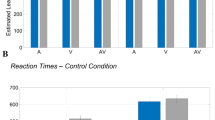Abstract
The experiment, aimed to evaluate the distracting effect of television, was carried out on 122 children, divided into three groups. All groups performed the auditory vigilance test (AVT) to assess reaction time (RT) to an auditory stimulus and the number of errors in responding to the stimulus. Children in group 1 performed the AVT while in front of a blank TV set and listening to the soundtrack of a movie (SO test), then watching a black and white cartoon (BW test). Children in group 2 performed the AVT while in front of a blank TV set and listening to the soundtrack of a movie (SO test), then watching a color cartoon (CC test). Group 3 performed SO, BW, and CC tests consecutively. RT and the number and type of errors were measured. In each group, 30 days separated one session from the following. A significant increase of median RTs (more than 10%) and errors (twice and more) was observed both in the case of BW and CC tests with respect to SO test. RT increased throughout all tests. During SO test, errors are mainly “false reactions”, but in BW and CC tests, errors are more numerous, and they are mainly “omissions”. TV movies have a significant distracting and attention-capturing effect, which increases throughout the vision of the show. No advantage in decreasing this effect is offered by removing color from the movie.


Similar content being viewed by others
References
Anderson DR, Lorch EP, Field DE, Sanders J (1981) The effect of television program comprehensibility on preschool children's visual attention to television. Child Dev 52:151–157
Anderson DR, Lorch EP, Field DE et al (1986) Television viewing at home: age trends in visual attention and time with TV. Child Dev 57(4):1024–1033
Baucum DG, Smith AE, Weisberg P (1974) Elimination of disturbing naptime behaviors of preschool children through withdrawal and re-presentation of TV audio reception. Psychol Rep 35(1):51–56
Broadbent DE (1971) Decision and Stress. Academic, London
Christakis DA, Zimmerman FJ, Di Giuseppe DL, McCarty CA (2004) Early television exposure and subsequent attentional problems in children. Pediatrics 113:708–713
Dworak M, Schierl T, Bruns T, Strüder HK (2007) Impact of singular excessive computer game and television exposure on sleep patterns and memory performance of school aged children. Pediatrics 120(5):978–985
Fontani G, Lodi L, Felici A et al (2004) Attentional, emotional and hormonal data in subjects of different ages. Eur J Appl Physiol 92:452–461
Fontani G, Maffei D, Cameli S, Polidori F (1999) Reactivity and event-related potentials during attentional tests in athletes. Eur J Appl Physiol 80:308–317
Gable S, Chang Y, Krull JL (2007) Television watching and frequency of family meals are predictive of overweight onset and persistence in a national sample of school-aged children. J Am Diet Assoc 107:53–61
Ishiguro Y, Takada H, Watanabe K et al (2004) A follow-up on seizures induced by animated cartoon tv program “pocket monster”. Epilepsia 45(4):377–383
Landhuis CE, Poulton R, Welch D et al (2007) Does childhood television viewing lead to attention problems in adolescence? Results from a prospective longitudinal study. Pediatrics 120(3):532–537
Lee JD, Caven B, Haake S et al (2001) Speech-based interaction with in-vehicle computers: the effect of speech-based e-mail on drivers' attention to the roadway. Hum Factors 43(4):631
Redfern MS, Müller ML, Jennings JR, Furman JM (2002) Attentional dynamics in postural control during perturbations in young and older adults. J Gerontol A Biol Sci Med Sci 57(8):B298
Richard CM, Wright RD, Ee C et al (2002) Effect of a concurrent auditory task on visual search performance in a driving-related image-flicker task. Hum Factors 44(2):108
Schmidt ME, Pempek TA, Kirkorian HL et al (2008) The effects of background television on the toy play behavior of very young children. Child Dev 79(4):1137–1151
Taddei N (1998) Dalla comunicazione alla lettura del film. EDAV Ed, Roma
Takada H, Aso K, Watanabe K et al (1999) Epileptic seizures induced by animated cartoon, “Pocket Monster”. Epilepsia 40(7):997–1002
Thompson DA, Christakis DA (2005) The association between television viewing and irregular sleep schedules among children less than 3 years of age. Pediatrics 116:851–856
Trimmel M, Poelzl G (2006) Impact of background noise on reaction time and brain DC potential changes of VDT-based spatial attention. Ergonomics 49(2):202–209
Welford AT (1980) Choice reaction time: basic concepts. In: Welford AT (ed) Reaction times. Academic, New York, pp 73–128
Wells JC, Hallal PC, Reichert FF et al (2008) Sleep patterns and television viewing in relation to obesity and blood pressure: evidence from an adolescent Brazilian birth cohort. Int J Obes 32(7):1042–1049
Zimmermann P, Fimm B (1992) Testbatterie zur Aufmerksamkeitsprufung (TAP). Psytest, Wurselen
Author information
Authors and Affiliations
Corresponding author
Rights and permissions
About this article
Cite this article
Bellieni, C.V., Fontani, G., Corradeschi, F. et al. Distracting effect of TV watching on children's reactivity. Eur J Pediatr 169, 1075–1078 (2010). https://doi.org/10.1007/s00431-010-1180-0
Received:
Accepted:
Published:
Issue Date:
DOI: https://doi.org/10.1007/s00431-010-1180-0




